Variable Bluet females with a blue 'tail light'!
John Muddeman
04/06/2009 14:44:51
A mass hatch of damselflies near Neusiedl-am-See was not what it first seemed, and female Variable Bluets Coenagrion pulchellum can have an Ischnura-like abdominal blue 'tail light' and the males ornatum-like toothed postocular spots!
Posted in: Dragonflies and Damselflies | Other | Non-Iberian
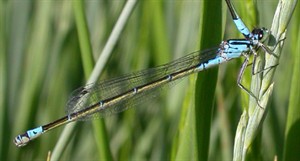 Female Variable Bluet showing 'tail light'© John MuddemanMid-morning on 21st May saw the Travelling Naturalist / Limosa group in E Austria watching singing Bluethroat, Moustached and Marsh Warblers, Penduline and Bearded Tits amongst other species near some pools close to Neusiedl-am-See.
Female Variable Bluet showing 'tail light'© John MuddemanMid-morning on 21st May saw the Travelling Naturalist / Limosa group in E Austria watching singing Bluethroat, Moustached and Marsh Warblers, Penduline and Bearded Tits amongst other species near some pools close to Neusiedl-am-See.
I suddenly became aware that the tall grasses along the track we were standing on was alive with hundreds of small 'blue' damselflies, but of just two colour types: in simple terms, one showed a rather blackish abdomen with a few blue patches (a bluet Coenagrion species), while the other appeared to be a bluetail Ischnura species, with a dark abdomen and a clear blue 'tail light'. However, it very quickly became apparent that these were males and females
of the same species, given many of these in tandem.
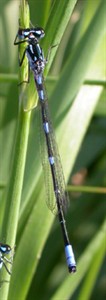 m Variable Bluet© John Muddeman
m Variable Bluet© John Muddeman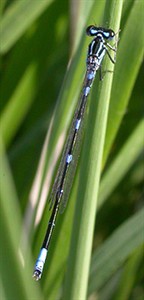 m Variable Bluet© John Muddeman
m Variable Bluet© John Muddeman 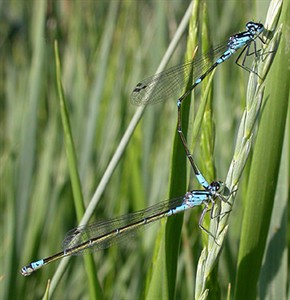 Variable Bluet pair in tandem (same f as above)© John MuddemanBeing unaware that females of any bluet species can have blue 'tail lights', I took a couple of pictures in the little time we had available. Although these are not particularly good, they quite clearly show a couple of interesting features which can be seen in the accompanying photos: the males showed a very consistently dark abdomen with only limited blue, but at least half (I estimate) showed broken antehumeral stripes, suggesting they were Variable Bluets C. pulchellum. But they also all showed toothed markings on the rear of the postocular spots, which is supposedly a feature of Ornate Bluet C. ornatum!
Variable Bluet pair in tandem (same f as above)© John MuddemanBeing unaware that females of any bluet species can have blue 'tail lights', I took a couple of pictures in the little time we had available. Although these are not particularly good, they quite clearly show a couple of interesting features which can be seen in the accompanying photos: the males showed a very consistently dark abdomen with only limited blue, but at least half (I estimate) showed broken antehumeral stripes, suggesting they were Variable Bluets C. pulchellum. But they also all showed toothed markings on the rear of the postocular spots, which is supposedly a feature of Ornate Bluet C. ornatum!
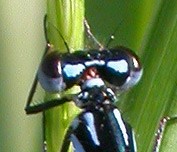 m Variable Bluet upper head© John Muddeman
m Variable Bluet upper head© John Muddeman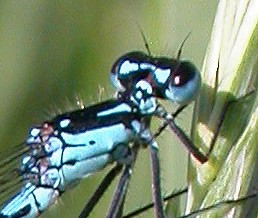 m Variable Bluet upper head & thorax© John MuddemanWhilst assuming they must be Variable Bluets (and so living up to their English name!), Florian Weihrauch was contacted and confirmed, as far as possible given the limitations of the photos, that these are indeed from a population of Variable Bluets, 'despite' the toothed rear margin of the post-ocular spots and the presence of the 'tail light' in the females. [With many thanks to FW for his comments].
m Variable Bluet upper head & thorax© John MuddemanWhilst assuming they must be Variable Bluets (and so living up to their English name!), Florian Weihrauch was contacted and confirmed, as far as possible given the limitations of the photos, that these are indeed from a population of Variable Bluets, 'despite' the toothed rear margin of the post-ocular spots and the presence of the 'tail light' in the females. [With many thanks to FW for his comments].
Read more blog posts